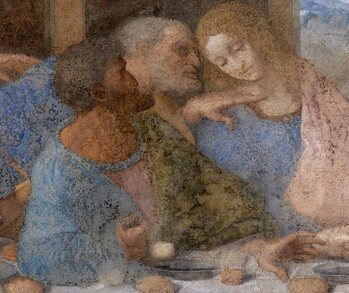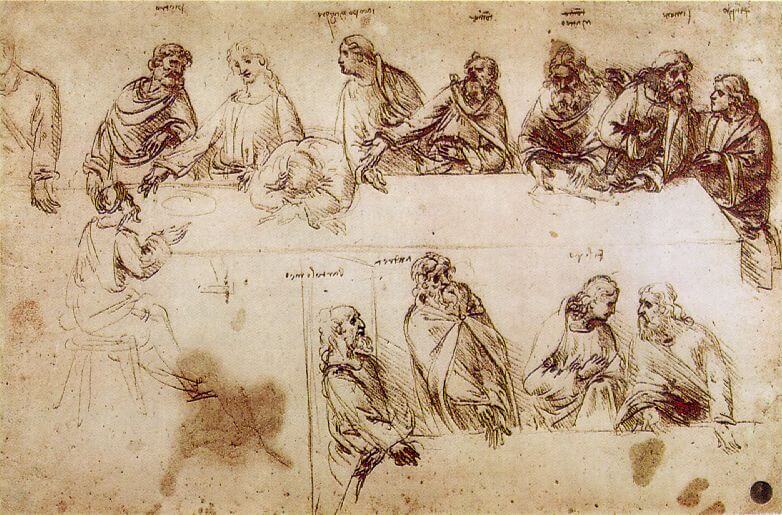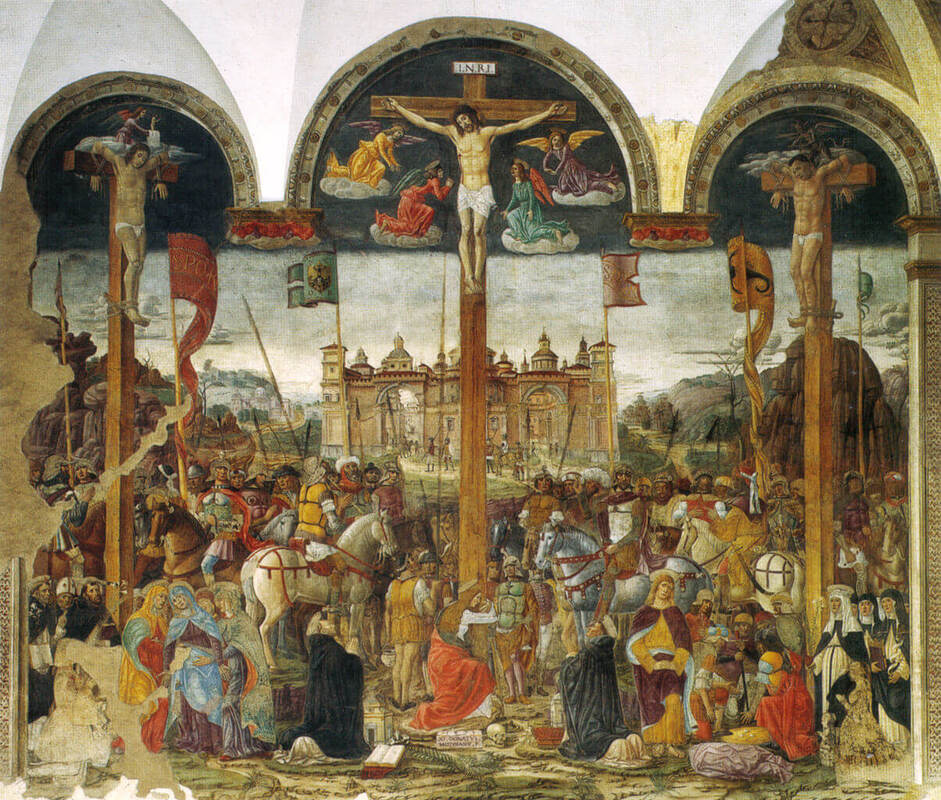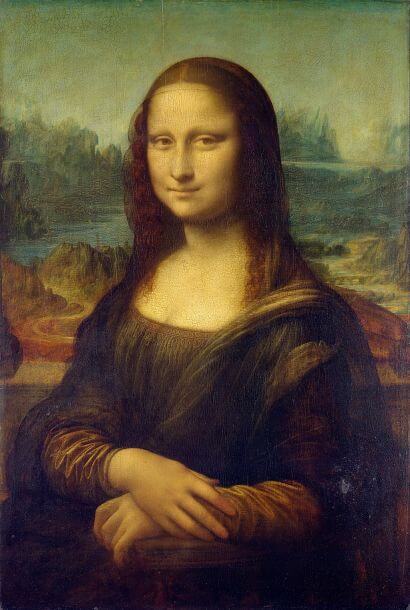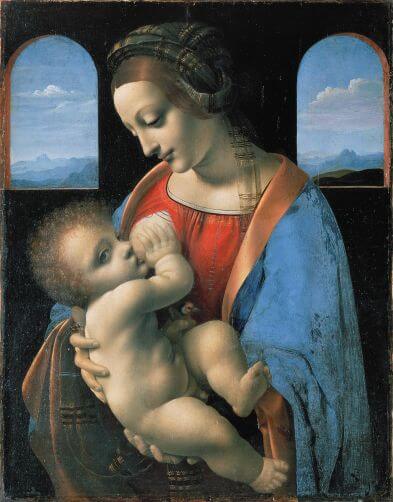|
Where? Santa Maria delle Grazie Dominican Church and Convent in Milan
When? 1495-1498 Commissioned by? Ludovico Maria Sforza, Duke of Milan between 1494 and 1499, for the renovations he had planned for the church and convent. What do you see? The Last Supper where Jesus and the 12 apostles are sharing their final meal before the crucifixion. The fresco is designed so that the space in which the last supper takes place looks like an extension of the architecture of the room itself. In the center is Christ. His outstretched arms touch the table. The 12 apostles are divided, first into two groups of six on each side, and second, into subgroups of three. Each subgroup is a tightly-knit group in composition. Scan the row of heads and see the wave-like arrangement, surging and ebbing.
The ceiling of the room is painted as if coffered, and the coffers provide a clear sense of depth to the mural. In the background are three windows with a view to the landscape. The center window behind Christ, has a semicircular pediment, suggestive of a halo. The right wall is illuminated and the left is in shadow.
Backstory: Leonardo da Vinci always carried a sketch book with him. He looked for facial expressions, bodily movement, and believed the artist had “two principal things to paint, man and the intention of his mind.” He has frozen these 13 men in a moment of time and by doing so, he captured all the drama and excitement of the Gospel verses in The Last Supper. Few sketches remain but below is an early version.
Da Vinci had indicated great concern about painting Christ’s face. Christ is larger than the others (hierarchical perspective) and this is also of theological importance. The spatial isolation of Jesus gives added importance to his image. Da Vinci also used the most expensive paint for Christ—ultramarine.
It is hard to imagine the reactions of the friars and nuns as they entered the refectory to see the mural for the first time (before the mural started to deteriorate). The light, bright, stunning colors of a well-known story told in a brand-new fashion must have been almost shocking. Gone were the traditional halos, the flat facial expressions, the formalism, and instead, a band of 13 young men are seen reacting to an announcement that none of them could believe would happen. The humanism of Da Vinci was a great surprise. In the silence of their shared meals it must have given them much to contemplate. Restoration: Leonardo da Vinci had no experience painting frescos before he started on this mural and used an experimental technique similar to painting on a wooden panel. As a result, the painting is in very poor state as Da Vinci painted on an outside wall with no space to prevent water damage, and he painted with a mixture of oil paint and tempura. The paint did not adhere to the wall and it was decaying even during Da Vinci’s lifetime. Numerous restoration attempts have been made over the centuries, but they usually caused further problems. In 1979, a small group of Italian art restorers began a huge project to properly do the job. It took them 20 years to complete. Symbolism: Christ’s simple pose is complex in detail and meaning—he is silent, sad, and submissive. His right hand extends toward Judas, whose hand is near his. Christ’s hand is palm down, accusing Judas. “The hand that betrayeth me is with me on the table.” At the same time, Christ’s right hand refers to the glass of wine, the symbol of his blood used in the Mass, while his left hand extending to the bread refers to the symbol of his body. The triangular pose of Christ is a reference to the Holy Trinity, an emblematic abstraction of his words, “He who has seen me has seen the Father.” The hand with the forefinger pointing straight upward to the right of Christ, belongs to Thomas. His probing finger refers to the physical resurrection of Christ and points to heaven as a harbinger of the physical ascension. Refectory of Santa Maria delle Grazie: The Last Supper measures 460 cm x 880 cm (15 ft x 29 ft) and covers the end wall of the refectory (dining hall) of the monastery. Painting the mural was not easy and a hazardous task as it was placed 15 feet above the floor. The theme of the Last Supper was a traditional one for refectories. The opposite wall of the refectory is covered by the Crucifixion fresco by Giovanni Donato da Montorfano, to which Leonardo da Vinci added figures of the Sforza family in tempura; these figures have deteriorated in much the same way as those in The Last Supper. Da Vinci worked very thoroughly but slowly and Montorfano was finished before him, to the consternation of Duke Sforza who exhorted Da Vinci to finish his project.
Who is Da Vinci? Leonardo da Vinci was born April 15, 1452 near Vinci in Tuscany. He was the illegitimate son of a 25 year old aspiring lawyer/notary, who had come home for the summer and met the young peasant girl Caterina. He was already engaged to be married but these occurrences were not particularly remarkable at that time.
His paternal grandfather took custody of Leonardo after the birth. The fact that Leonardo was not a legitimate son may have been quite fortunate, as the first legitimate son would have had to follow in his father’s footsteps and become a lawyer. His grandfather allowed him free reign to pursue other interests. When Leonardo was 15 years old, he was sent to Florence to work as an apprentice to Andrea del Verrocchio. He excelled and by the time he was 25, he had his own studio with students. He applied to the Duke of Milan and moved there when he was 30. In 1499, following the Duke’s fall from power, he left Milan and spent a short time in Venice. He returned to Florence in 1500 and in 1516 he moved to France at the invitation of King Francis I. He died there in 1519 at age 67. Among his most famous works are the Mona Lisa in the Louvre and the Madonna Litta in the Hermitage Museum.
Fun fact: The rules of perspective that were used, bring about an unusual effect. This is especially true when looking at the table. The top of the table is always visible, no matter the angle at which you look at the painting. The nuns and friars in the refectory would be sitting well below the mural and it was important that they could see the bread and wine in this fresco.
Another interesting aspect of the fresco is the bottom center of the mural, where a doorway has been cut into the painting. In 1652, the kitchens were relocated to the room behind the refectory and they wanted easier access to the room. They cut out a good portion of the painting, included the feet of Jesus. Fortunately, in 1520, Giampietrino had made a copy of the original in oil on canvas. We can see Jesus’ feet and also the salt cellar spilled by Judas that is no longer visible in the original fresco by Da Vinci. This copy by Giampietrino was very important for the restoration of The Last Supper between 1979 and 1999.
1 Comment
|
Categories
All
|
- Home
- Blog
-
Museums
- Alte Pinakothek
- Art Institute of Chicago
- Baltimore Museum of Art
- Barber Institute of Fine Arts
- Bargello
- Barnes Foundation
- British Museum
- Church of Sant’Anastasia
- Cleveland Museum of Art
- Courtauld Institute of Art
- Detroit Institute of Arts
- Frans Hals Museum
- Galleria Borghese
- Gallerie dell'Accademia
- Getty Museum
- Guggenheim
- Hermitage Museum
- Kunsthistorisches Museum
- Kunstmuseum Basel
- Legion of Honor Museum
- Louvre
- Mauritshuis
- Metropolitan Museum of Art
- Musee d’Orsay
- Museum of Fine Arts in Boston
- Museum of Modern Art
- National Gallery in London
- National Gallery of Art
- National Museum in Poznań
- Norton Simon Museum
- Ny Carlsberg Glyptotek
- Palace of Versailles
- Palazzo Pitti
- Palazzo Vecchio
- Petit Palais
- Philadelphia Museum of Art
- Prado
- Pushkin Museum
- Ravenna Art Museum
- Rijksmuseum
- San Diego Museum of Art
- Santa Maria delle Grazie
- St. Peter's Basilica
- Städel Museum
- Statens Museum for Kunst
- Tate Britain
- Tate Modern
- Timken Museum of Art
- Uffizi
- Vatican Museums
- Wallace Collection
-
Artists
- Altdorfer
- Anguissola
- Berlin Painter
- Bosch
- Botticelli
- Boucher
- Bronzino
- Bruegel the Elder
- Brunelleschi
- Cabanel
- Caillebotte
- Canova
- Caravaggio
- Carpeaux
- Cezanne
- Cimabue
- David
- Degas
- Delacroix
- De Maria
- Donatello
- El Greco
- Fontana
- Fra Angelico
- Fragonard
- Gauguin
- Gentileschi
- Gericault
- Gonzalez-Torres
- Goya
- Hals
- Hogarth
- Hokusai
- Ingres
- Leonardo da Vinci
- Lippi, Filippo
- Longhi, Barbara
- Lorrain
- Makovsky
- Manet
- Massys
- Matisse
- Merian
- Michelangelo
- Mochi
- Modigliani
- Monet
- Panini
- Parmigianino
- Perugino
- Picasso
- Pisanello
- Raphael
- Rembrandt
- Renoir
- Reynolds
- Rivera
- Rodin
- Rubens
- Scultori
- Seurat
- Steen
- Tintoretto
- Titian
- Toulouse-Lautrec
- Turner
- Uccello
- Van der Weyden
- Van Dyck
- Van Eyck
- Van Gogh
- Van Hemessen
- Vasari
- Velazquez
- Vermeer
- Veronese
- Vigée Le Brun
-
Locations
- Books
- About Us


